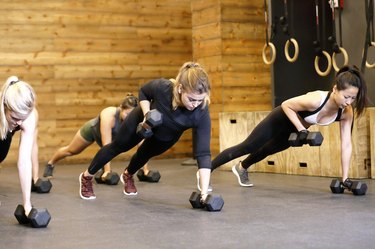
Steroids are injected into the hip for a variety of reasons, from hip pain management to maternal-fetal treatment. When you receive a hip injection, you'll notice a slight burning sensation and even achiness, but the steroids shouldn't impede your ability to exercise after a cortisone injection in your hip. In fact, hip cortisone injection recovery time is typically short, after which you should be able to resume full physical activity within the parameters set for you by your doctor or physical therapist.
Tip
Recovery from steroid injection is typically quick. You will likely be back to your normal activities within 24 hours.
Video of the Day
Read more: Sudden Pain in My Hip After Exercising
Video of the Day
Steroid Shot for Inflammation
When you're issued a steroid shot for inflammation, the procedure is done in-office or in a hospital clinic. The injection site is cleaned and the steroids are injected into the hip. After the injection, the nurse or doctor issuing the shot rubs the injection site to disperse the steroids. Hip cortisone injection recovery time is anywhere from 15 to 30 minutes, during which you'll be monitored for adverse reactions. Typically the only side effects include pain, redness and swelling at the injection site.
Get Up and Go
You'll be able to resume walking directly after the short recovery period in your doctor's office. In fact, walking after your steroid shot for inflammation helps to disperse the medicine and prevent stiffness in the hip at the injection site. You won't need any special attention following the injection unless you've had a reaction to the steroids. Still, your doctor might caution you to avoid high-intensity activity directly after the injection, since excess movement could cause you more pain and swelling at the injection site.
Back at It
Barring any adverse steroid shot side effects, you'll be able to resume full-intensity exercise 24 hours after your injections. It may be helpful to resume exercise slowly to avoid excess pain. Start with a warm-up and assess your pain level before you begin exercising at full intensity, or participate in a low-impact activity such as swimming or yoga to avoid pain. You shouldn't have to limit your physical activity after injection unless you have a reaction that requires medical attention.
Treat Temporary Pain
If the injection site is still mildly painful in the days following your steroid shot, that pain shouldn't be so severe that it stops you from exercising.
However, according to Kaiser Permanente, although not common, some people experience a steroid flare within the first few days after an injection during which your symptoms get worse.
Pain and tenderness from a steroid flare can be treated with the use of over-the-counter pain medications, such as ibuprofen. Applying an ice pack to the injection site also relieves pain and swelling so you're back in the game faster.
Steroid Shot Side Effects
Although rare, there are negative steroid shot side effects that can occur. This procedure temporarily increases blood sugar levels — particularly if you have diabetes. You might experience bleeding or bruising at the injection site. Infection can develop, or you might have an allergic reaction to the steroid medication.